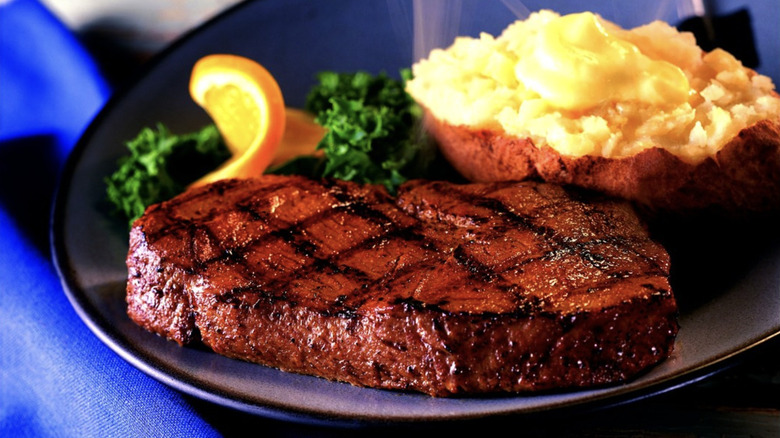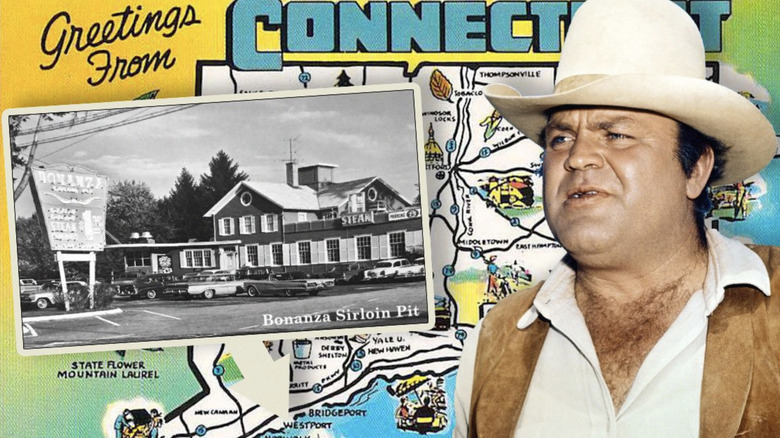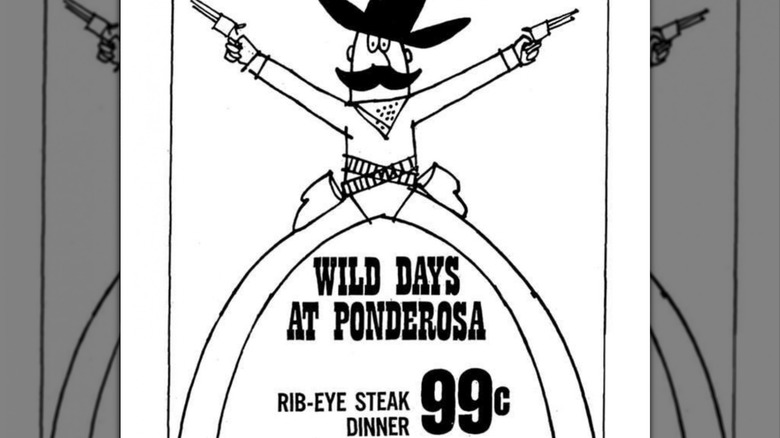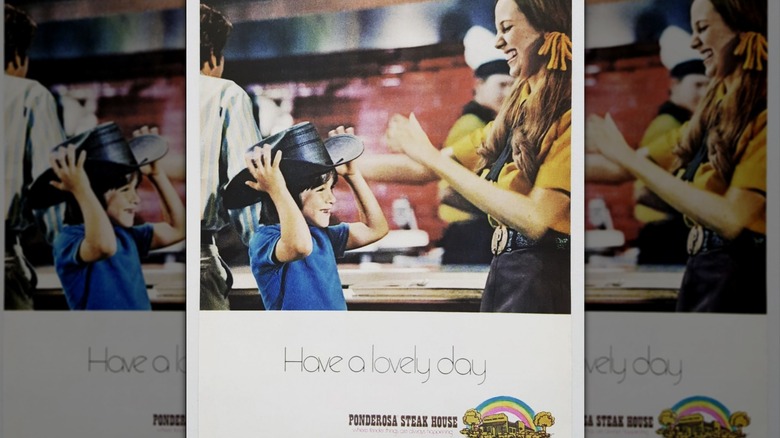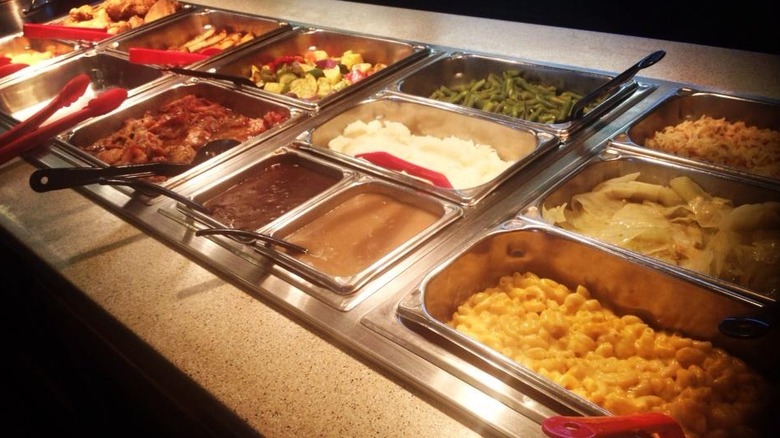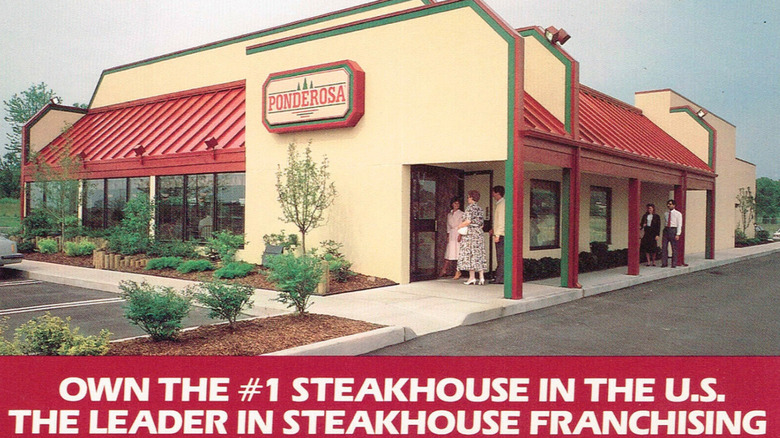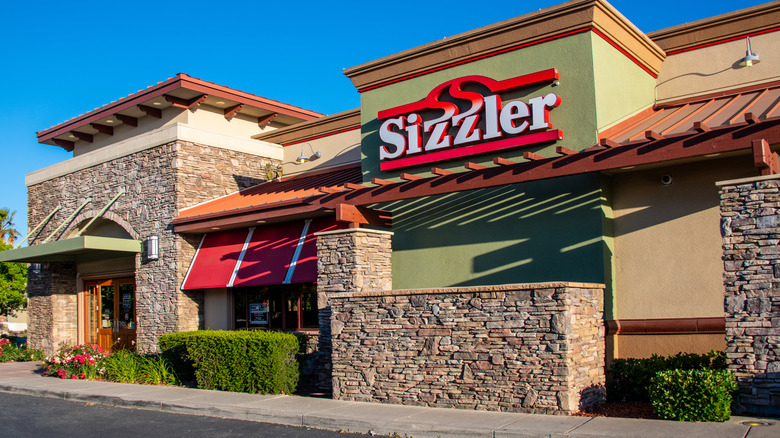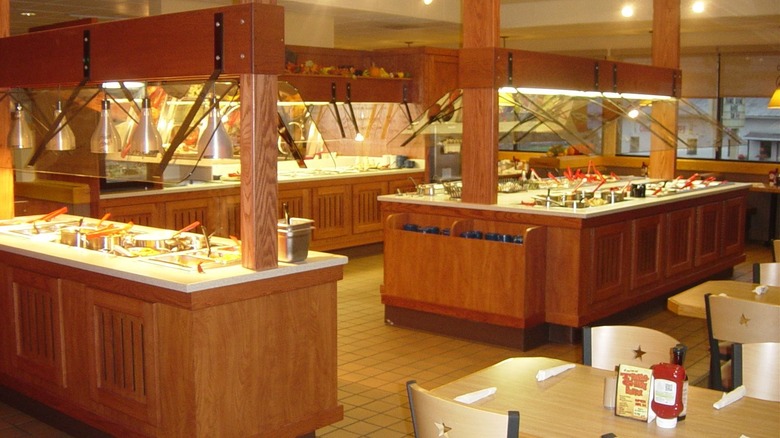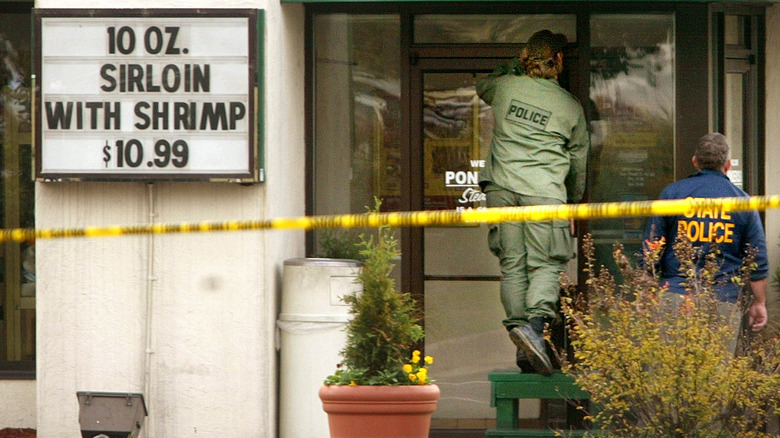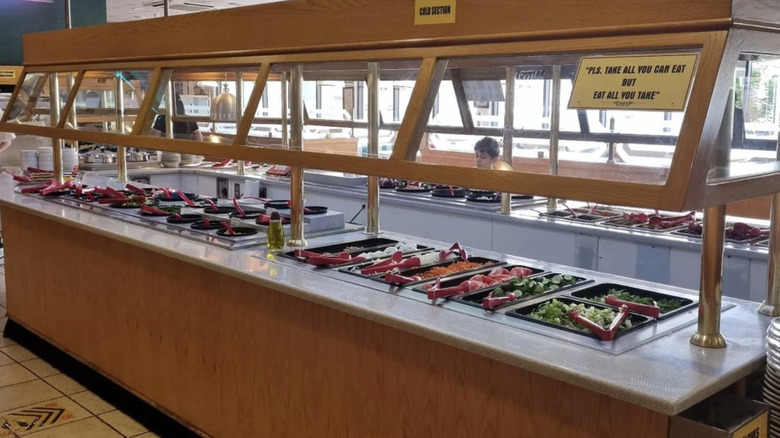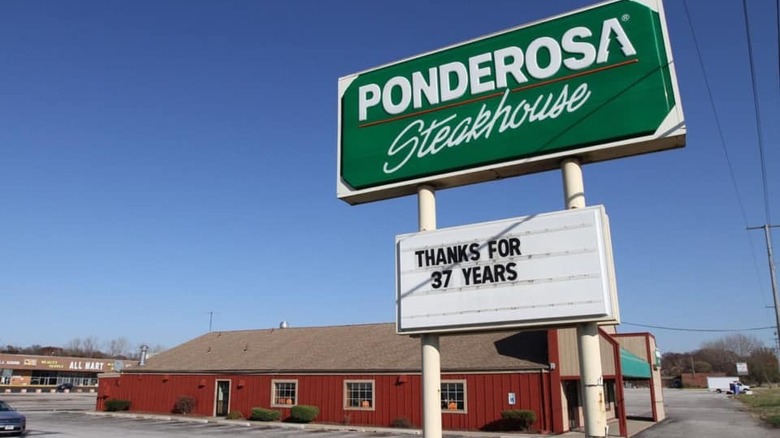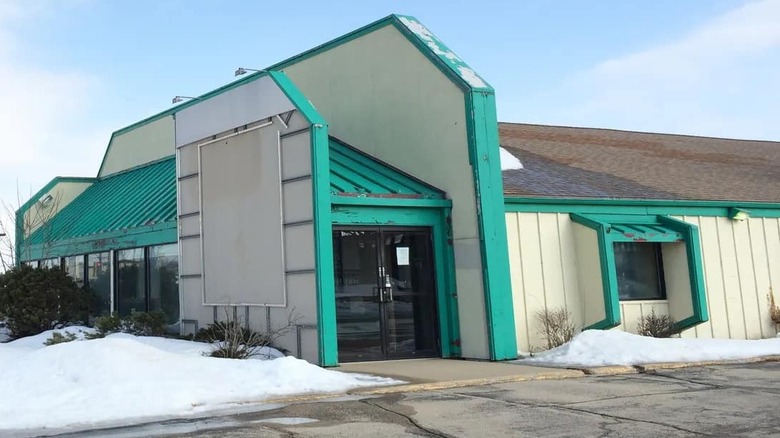The Rise And Fall Of Ponderosa Steakhouse
An earlier version of this article incorrectly stated that Hepatitis A was a bacteria when, in fact, it is a virus. Muhammed and Malvo were not father and son; Malvo looked to Muhammed as a father figure.
On its company website, Ponderosa Steakhouse (and its sister company Bonanza Steakhouse) paints a rosy picture of its Americana roots and homestyle appeal, and we can't fault the temptation to look on the bright side of history when the future looks a little grim. In the modern age, Ponderosa has struggled to prosper the way it did in the latter half of the 20th century. However, the hardships endured by this once-popular all-you-can-eat restaurant chain speak as much to cultural shifts as to the fragile business model of steakhouse buffets in general.
Ponderosa was, in many regards, the ultimate family restaurant. The meals were inexpensive, the buffet was a beacon of variety, and few phrases have unleashed hungry crowds quite like "all you can eat." At its peak era of the early 1990s, there were upwards of 700 Ponderosa locations. Slowly but surely, Ponderosa Steakhouse, a place that was once such a mainstay off of highway exits and in sleepy small towns, began closing one location after another. Now, you'd probably have a hard time finding someone under the age of 25 who's even heard of Ponderosa, let alone eaten at one. The only way to understand the rise and fall of Ponderosa Steakhouse is to start at the beginning. Here's how it all went down.
Bonanza Steakhouse was the inspiration for Ponderosa Steakhouse
Themed restaurants have been part of the American dining experience since the late 1800s, and by the mid-20th century, they were a common sight in most U.S. states. When Dan Blocker, the actor who played Eric "Hoss" Cartwright in the popular Western TV show "Bonanza," decided to hang up his hat after four seasons, his next act was opening a restaurant. Inspired by his years of playing a rancher on TV, Blocker opened Bonanza Sirloin Pit in Westport, Connecticut, in 1963, and the cowboy-themed restaurant caught on. Two years later, businessmen Dan Lasater, Norm Wiese, and Charles Kleptz opened a similar restaurant in Kokomo, Indiana called Ponderosa Steakhouse — Ponderosa was the name of the ranch on "Bonanza."
In 1966, just a year after the launch, Ponderosa began franchising, which helped expand the business. Meanwhile, Blocker had sold the restaurant — which by November of 1965 had grown to 32 locations and counting — to brothers Sam and Charles Wyly, who franchised the chain simply as Bonanza Steakhouse. Ponderosa and Bonanza were known for selling steak, chicken, and seafood dinners at a low price, along with an all-you-can-eat salad bar and dessert. Both eateries emphasized a casual, "come as you are" environment in an era when many steakhouses required men to wear a sports coat or suit jacket to dine there. This informal, inclusive approach to the steakhouse restaurant format drew in a lot of customers.
Ponderosa Steakhouse expanded quickly and became Bonanza's biggest competition
Seeing as Bonanza and Ponderosa were such similar operations, the restaurants became one another's biggest competitors for the next two decades. Bonanza lured in patrons with steak dinners priced between $0.99 and $1.99. There was a no-tipping policy and free refills on coffee and soft drinks. Ponderosa advertised near-identical deals: ribeye or chopped steak dinners were under two dollars. Hamburgers and sandwiches were under a buck. Tuesday was "Family Day" at the dueling steakhouses, a time when mom, dad, and the kids could feast for $1.49 each.
Prices were hard to beat, and the buffet was a sensation. In the 1970s, it wasn't uncommon to see lines forming outside the door. Ponderosa got creative with its advertising around this time. The steakhouse would accept customers' 50¢ McDonald's coins in exchange for one dollar off their meal, a tactic so rogue it felt like the Wild West.
As both steakhouses spread across the states, Ponderosa and Bonanza spent the 70s and 80s duking it out in Canada. In some instances, a Canadian Ponderosa would go out of business and become a Bonanza Steakhouse. By 1984, Ponderosa sold its Canadian outposts to General Mills Restaurant Group, which promptly turned all 36 locations into Red Lobsters. Back in the States, the turf war continued, but because Ponderosa's stock shares were more profitable than Bonanza's, Ponderosa was considered the largest steak chain in the nation.
The food was just ok, but kids loved it
Ponderosa implemented a business model that didn't seem cost-effective, but it worked. Offering affordable, plentiful meals and posturing its interiors as a lively, family-friendly place where heaping plates of steak, salad, and sides flowed as freely as the soft serve machine got people in the door. It also meant cooking (and wasting) large amounts of food. One way Ponderosa was able to turn a profit as an all-you-can-eat buffet was by skimping a bit on the quality of the food.
USDA Prime Beef, preservative-free gravy, and organic sides weren't the name of the game here. Then again, when you consider the price points, customers can hardly be shocked to learn that Ponderosa's steaks came frozen and pre-seasoned. Chopped steak — one of Ponderosa's best-known dishes — is an effective way to camouflage texture issues that can arise when cooking frozen steak. Highbrow dining was not the point of eating at Ponderosa. It was a place where adults could take the kids out for a meal without spending more than they were able to. And the kids were grateful.
The internet is flooded with Gen X-ers' and Millenials' childhood memories of exploring Ponderosa's buffet in wonderment. There were tacos and fried chicken. Trusting parents could let kids operate the soft serve machine themselves and shower the frozen peaks of confection with an obscene amount of sprinkles. At the end, they could choose a toy from a mystery bag.
The steakhouse helped popularize all-you-can-eat buffets ... but it didn't invent them
For many, especially youngsters, a trip to Ponderosa was their first time going to an all-you-can-eat buffet. Ponderosa Steakhouse offers breakfast, lunch, and dinner buffets. However, the buffet concept originates far away from the cowboy ranches of the U.S. At its core, a buffet is nothing more than an elaborate display of different foods. It wasn't until the 16th century that the spread got an official name.
This seemingly bottomless collection of food — mostly finger foods and other hors-d'oeuvres was customary at festive events in Sweden, where it was called brännvinsbord, which translates to "table of spirits." A brännvinsbord (later renamed to the more recognizable smörgåsbord) isn't meant to be an exercise in non-restraint though. Customarily, the foods are set out in a specific order and meant to be consumed little by little. As we know, the Americans do it differently.
The bountiful nature of a smörgåsbord naturally tows the lines of excess consumption, so it feels appropriate that America's first buffet establishment stretched its legs on the Las Vegas strip. The Buckaroo Buffet at the El Rancho Vegas casino sold an all-you-can-eat spread, mostly consisting of sandwich ingredients and deli salads, for $1 around 1945 as a way to keep people in the casino longer. After that, Bonanza and Ponderosa brought this bang-for-your-buck style of dining to America's mainstream.
Ponderosa merged with Bonanza Steakhouse in the 1980s
The rivalry between Bonanza and Ponderosa Steakhouse played out longer than some restaurants even last, but the carousel of one-upping came to a head in the late 1980s. By that time, Bonanza Steakhouse had amassed close to 600 active locations. Ponderosa, the leading steakhouse chain in the U.S., had over 700. Bonanza launched a takeover bid to acquire Ponderosa Steakhouse around 1984 but was unsuccessful. Ponderosa had staved off numerous takeover attempts that decade and the battles had been costly.
Behind the scenes, Ponderosa was also experiencing significant problems with its infrastructure. The chain couldn't seem to secure a long-term CEO while simultaneously being criticized for its outdated dining rooms and menu options. In 1988, Metromedia Company, a privately owned conglomerate, set on buying up popular steakhouse chains purchased Ponderosa. Metromedia paid $8.6 million in cash and took on Ponderosa's $290 million debt to assume ownership. Shortly after, Metromedia also bought the once-popular Steak & Ale franchise and then Bonanza Steakhouse.
The merger initially caused a multi-million dollar drop in Metromedia's net income, but new business strategies were in the works. A renewed focus on employee training, modernization, and quality customer service was enacted to boost Ponderosa's image. Plus, now that Ponderosa and Bonanza were operating under the same financial umbrella, the total number of locations was combined. As the early 90s began to take shape, Ponderosa and Bonanza had over 1,300 worldwide locations to its name.
Despite its success, Ponderosa couldn't catch up to Sizzler's sales
The cracks in Ponderosa's business dealings began to show in the 1980s; however, the restaurant was far from ruined. Throughout the tumultuousness, Ponderosa maintained its spot as the number one steakhouse chain in annual sales until 1993. That was the year Ponderosa slipped into second place behind Sizzler.
At that point, Ponderosa was approaching 30 years of business, and Sizzler was in its 35th. Sizzler began in 1958 as a husband-and-wife operation in Culver City, California, and in more ways than one, was a precursor to Bonanza Steakhouse and, later, Ponderosa. In Sizzler's earliest days, the restaurant advertised a budget steak dinner: New York Strip, fries or a baked potato, and a buttered roll for $1.59. There was also a firm no-tipping policy. Sound familiar? Sizzler took off quickly, expanding to 13 locations in just two years. To compete with a heavyweight like Ponderosa, Sizzler adopted its ways.
In 1991, Sizzler took its salad bar to the next level by transforming it into a full-fledged buffet — just like the one at Ponderosa. Shortly after the rebrand, Sizzler was riding high, outperforming Ponderosa in sales by more than $100 million. The glory would be short-lived. Sizzler took on too much too fast, expanding its presence in Australia in the early 90s and allowing unsafe food serving practices to run rampant at its buffet. By 1996, Sizzler filed for bankruptcy while Ponderosa held on.
There was a lot of food poisoning going on at the buffet
This wasn't so much a Ponderosa problem as it is a buffet problem. Buffets are a notorious site for food-borne illnesses. In 1993, Sizzler weathered controversy when E. coli-ridden meat contaminated the salad bar at locations in the Pacific Northwest, resulting in 39 confirmed food poisoning cases and likely dozens more (it happened again in Milwaukee in 2000). The largest Hepatitis A outbreak in American history occurred at Chi-Chi's in November 2003 when green onions containing the virus killed four people and poisoned more than 600. Ponderosa wasn't without its pains, either.
A website called iwaspoisoned.com has a section dedicated to Ponderosa where people can report the details of suspected food poisoning after dining at the restaurant. Some complaints describe instances where the items sat out too long, which is one of the main reasons why buffet food develops bacteria in the first place. Another risky practice that's common in buffets is cross-contamination. E. coli outbreaks like the ones at Sizzler and other chains were caused by fresh produce coming into contact with raw meat.
In 2019, a Ponderosa in Hazard, Kentucky, which has since shut down, attempted to inspire confidence by announcing via Instagram that all of its employees had received a Hepatitis A vaccine. Not only would this claim be almost impossible to prove, but it's unlikely that Ponderosa franchisees nationwide would be required to uphold the same standard.
Some of Ponderosa's franchisees were white-collar criminals
Franchising a restaurant is a surefire way to grow the business, yet it also invites some rogue characters to get in on the action. This is precisely what happened to Ponderosa in 2008. Fred Boukzam, who, as president of Pon Management, owned 15 Ponderosa locations in Northeast Ohio, was caught in a check kiting scheme that resulted in an $824 million case of bank fraud.
Boukzam pulled off the scheme by inflating the balances of multiple business accounts and then passing bad checks between said accounts. Banks automatically credit the check amount to cover the lag between when it's deposited and when it's cleared (known as a float). When the "kited" check is floating between two accounts, it briefly acts as a line of unauthorized credit. Boukzam took advantage of this and wrote 44,000 bad checks, using four of his Ponderosa business accounts to prop up his crime. He was sentenced to 33 months in jail, and over 12 of his Ponderosa restaurants were shuttered.
And then there's the oldest white-collar trick in the book: tax evasion. That's what Scoott A. Wildey, owner of a Ponderosa in Greensburg, Indiana, was jailed for in 2014. The feds conducted an investigation that showed Wildey hadn't properly filed taxes for two years.
Ponderosa was a target for robberies and other violence
A bustling dining room full of customers and a cash register full of cash made Ponderosa vulnerable to robberies. One of the first publicized instances took place in 1975 when three men armed with a shotgun, pistol, and knife held up a Ponderosa in Bloomington, Illinois, around closing time. In 1996, a trio of masked men entered through the back door of an Ohio Ponderosa after closing time. Armed with guns, the robbers held the manager and six employees hostage and engaged in a 12-hour standoff with police. While racing to the scene, one of the responding officers was involved in a car crash, and a civilian passenger was killed.
This was not the only deadly robbery in Ponderosa's history. In 1999, three Detroit men robbed Gary Urban, who managed a Ponderosa in nearby Dearborn Heights. Urban was held at gunpoint as he walked to his car after closing the restaurant, and despite complying with the gunmen's demands, he was shot seven times in the back and did not survive. One of the gunmen worked at the Ponderosa as a dishwasher.
As if this wasn't disturbing enough, a Ponderosa parking lot in Ashland, Virginia, was singled out by the infamous D.C. Sniper. The sniper duo, John Allen Muhammed and Lee Boyd Malvo, shot 37-year-old John Hopper as he walked out of Ponderosa with his wife. Thankfully, the victim survived.
A change in food trends in the 2000s put many Ponderosas out of business
Sometimes, fried chicken, pizza, mac & cheese, and all the bad things are exactly what you want, and if that's the case, Ponderosa is the place to be. Yet most of the time, people generally try to avoid eating plate after plate of junk food. As time has gone on, many fast-casual eateries have succeeded in peddling healthier, more unique choices to the price-conscious public, and it's a notion that has hurt Ponderosa's business for a while now.
The writing has been on the wall since the 90s and even before. Customers were seeking lean meats, fish, or chicken in more controlled portions, and embracing cultural foods that are naturally healthier, like sushi or tofu-based dishes. Sure, Ponderosa does offer grilled chicken and salmon on its entree menu, but it feels like an obligatory inclusion to an outdated format rather than the star of the show ... and customers noticed.
Metromedia, the powerhouse company that bought Ponderosa and Bonanza in the late 1980s, filed for Chapter 11 bankruptcy protection in 2008. In conjunction with falling out of style with 21st-century tastes, Ponderosa, like much of the dining industry, was rattled by the challenges of the Great Recession.
The COVID-19 pandemic caused even more Ponderosa locations to close
Ponderosa was already struggling to stay alive in the 2000s. With every passing year, more and more Ponderosa locations were closing their doors for good due to the inability to keep up with financial demands. In 2019, there were just 75 Ponderosas left on earth, 19 of which were operating outside of the U.S. in places like Qatar, the United Arab Emirates, Egypt, and Taiwan. Then came the COVID-19 pandemic.
We don't need to get into all of the ways that COVID decimated the restaurant industry as we once knew it. But for a poorly aging restaurant empire, one that relied so heavily on the foot traffic within its buffet stations, it was simply the final curtain. Even in tough times, certain Ponderosa locations consistently performed well, like the one in Beech Grove, Indiana, that had recently led the chain's sales couldn't stand up to COVID. The year 2020 saw a rising number of Ponderosa Steakhouses close due to the sharp decline in business. Many of them, like one in Louisville, Kentucky, or another in St. Petersburg, Florida, had been open for over 30 years.
There are barely any Ponderosa steakhouses left
It's mind-boggling to think that in the early 90s, when Ponderosa had been newly bought out by Metromedia Company, the restaurant drew bad press for dropping to the second-highest-grossing steakhouse chain — a position it held for many years. At that point, there were still roughly 700 locations in business. In the tentative wake of the post-pandemic age, Ponderosa (and Bonanza) have less than 20 locations left.
Ultimately, it wasn't just the restaurant-destroying pull of COVID-19 to blame for Ponderosa's fall from grace. Today's diners want more than heaping piles of eclectic food options packed under the illuminated hoods of retro buffet stations. The general public has evolved its expectations of what casual sit-down dining establishments can and should be, and if it's junk food they crave, well, there's always fast food. Still, we cannot reduce Ponderosa Steakhouse to a tragic footnote in American restaurant culture, because, at one time, it was more than that. When people pop into the scarcely encountered Ponderosa for a bite, they aren't expecting to revel in the satisfaction of a homestyle meal for cheap the way they did in bygone decades. They're simply there for the salty-good taste of nostalgia ... while it still exists.
